#rudolf ising
Text

“Who Found Roger Rabbit” Early Development Art For A Prequel Idea That Ended Up In Limbo Alongside “Toon Platoon” & “Who Discovered Roger Rabbit”…(80s-90s)
Source: https://comics.ha.com/itm/animation-art/concept-art/who-found-roger-rabbit-early-development-story-sketch-walt-disney-1988-/a/7268-17274.s
#80s#90s#amblin#disney#paramount#warner bros#mgm#concept art#period piece#1930s#fleischer studios#Hugh harman#rudolf ising#ub iwerks#koko the clown#betty boop#bimbo dog#flip the frog#bosko#fitz#roger rabbit#jessica rabbit#crossover#mash up#unproduced#never made
166 notes
·
View notes
Text

Walt Disney, Ub Iwerks, Rudolf Ising and Hugh Harman acting like a bunch of clowns
#walt disney#ub iwerks#rudolf ising#hugh harman#animators#disney#disney animation#disney animators#1920’s#20s#20s animation#old cartoons#cartoons
20 notes
·
View notes
Text
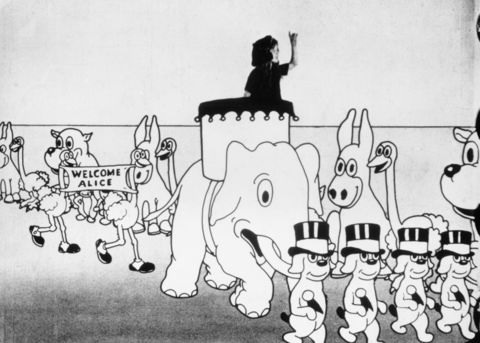
Alice's Wonderland (1923 short)
One hundred years ago today, Walt Disney screened to Margaret Winkler his hybrid animated/live-action short film, Alice’s Wonderland. If the name Margaret Winkler is unfamiliar to you, that is in part due to the fact that much of Hollywood’s mythmaking has obfuscated the impact of certain female creatives during the silent film era. A former secretary to Harry Warner at Warner Bros., Winkler was the premier animated short film executive in the early and mid-1920s. Her company, M.J. Winkler Pictures, flourished at a time before the oligopoly of the soon-to-be-major Hollywood studios, mostly on the backs of Pat Sullivan and Otto Messmer’s Felix the Cat series. At the peak of Felix’s popularity in 1923, a series of arguments between Winkler and Sullivan/Messmer soon meant Winkler was looking for an animated series to replace Felix. She would also be losing the rights to Max and Dave Fleischer’s Out of the Inkwell series, starring Koko the Clown. By the end of 1923, Winkler would sign a deal with Disney to distribute the Alice Comedies.
Impressed by the handiwork of Alice’s Wonderland, Winkler’s deal gave Walt Disney a much-needed infusion of cash. Disney, who founded Laugh-O-Gram Studios in Kansas City, Missouri in 1921, had just barely emerged from Laugh-O-Gram’s bankruptcy. Instead of heading to the then-center of the American animation world of New York City, Walt instead found himself in Los Angeles, partly to help his brother, Roy O. Disney, recover from tuberculosis.
Though a continent away from the major animation players in the U.S. at the time, Disney nevertheless took inspiration from those figures – Bray Productions under John Randolph Bray and especially the animator Winsor McCay (who, by 1921, was forced by employer William Randolph Hearst to stop working on animated film). McCay and Bray were pioneers in gifting animated characters basic personalities and the development of those personalities, growing animated cinema beyond modest gag comedy and simplistic figures. McCay’s Little Nemo (1911) and Gertie the Dinosaur (1914) and Bray’s Bobby Bumps series (1915-1925) may seem quaint to modern audiences, but these films were wildly popular across North America and were instrumental stepping stones to the explosion of American animated innovation in the late 1920s and 1930s.
Alice’s Wonderland was never screened for the public, but it nevertheless spawned a series that lasted for fifty-seven short films. None of it would have been possible without the inspiration Disney and his animators took from the most acclaimed American animation at that time.
With no relation to Lewis Carroll’s two Alice books, Alice’s Wonderland stars Virginia Davis as the title character. Davis, as Alice, is four years old at the beginning of the Alice Comedies series. She visits the animation studio where she sees Walt Disney in the process of drawing some “funnies”. As she sits down, the cartoons on the drawing pages come to life. Most important among those animated figures is Julius the Cat, created by Disney and Ub Iwerks and a predecessor to Oswald the Lucky Rabbit and Mickey Mouse (unlike Oswald and Mickey, Julius has not appeared in an animated film since the silent era). Walt then brings Alice into the animators’ room, where Ub Iwerks, Hugh Harman and Rudolf Ising, and others are also enjoying their work acting out various scenarios (remember those names – we will mention them again later). Alice, still giddy after her visit to the animators’ studio, later drifts off to sleep that evening. And, after dozing off, she finds herself welcome to a Cartoonland of her dreams.
At the time, Alice’s Wonderland was the reverse of what the Fleischers’ Out of the Inkwell series and some of the Bray and McCay shorts attempted. Instead of animated characters inhabiting a live-action world, we have here a live character traipsing around in an animated world. In some of the hybrid animated/live-action short films at the time, the reactions of the characters can be noticeably off. Not so much here. Davis’ reactions to the animated animals are timed with admirable precision. But given the technological constraints at the time and how small Walt Disney’s animators’ team was, Alice’s Wonderland makes heavy use of recycled or looped animation. Viewers who know their Looney Tunes or Hanna-Barbera works probably recognize the effects of a wraparound background and identical walking animation. The effects tend to make certain scenes – such as Alice’s celebratory procession during her dream – last several seconds too long.
youtube
Yet, Alice’s Wonderland still charms. With synchronized sound still four years away, the animators of the early twentieth century set the visual slapstick language that continues to course through modern animated cinema. Julius’ hidden fight with a dog within the latter’s doghouse, an animator using a pen holder as a de facto boxing bell, and a hungry lion cleaning and sharpening his teeth are just previews to the absurd humor that will define the next few decades of American animated short films. So too the tubular limbs from the animated characters. The film’s humor came not just from the films of Bray, McCay, and the Van Beuren Studios, but also the comic strips popular at this time – titles which probably read as quite unfamiliar to most today: Bud Fisher’s Mutt and Jeff (1907-1983; Fisher ceased involvement in 1932), George Herriman’s Krazy Kat (1913-1944), and Winsor McCay’s Dream of the Rarebit Fiend (1904-1925). These comic strips, largely unknown quantities to yours truly while researching for this write-up, influenced the comedic pace and tone for the bulk of American animated short films – a near-forgotten legacy, and one worthy of honoring.
Alice’s Wonderland would solidify the careers of all of the animators involved – all of whom were originally based in the Kansas City area. Walt Disney and Ub Iwerks stayed onboard what would be deemed the Disney Brothers Cartoon Studio (after several name changes, it is now the Walt Disney Animation Studios of today). Disney’s namesake studio is the most visible animated studio in all of cinema, and undoubtedly the most historically and currently significant, for good and ill. For the Alice Comedies, Iwerks experimented with a “matte” – in which a cutout background would be placed over a camera lens to hide where animated figures might be. Iwerks also developed Mickey Mouse with Walt, was one of the leading hands on the Silly Symphony series, and was integral in developing the special visual effects that made animated/live-action hybrid movies like Song of the South (1946) and Mary Poppins (1964) as convincing as they are.
Hugh Harman and Rudolf Ising, who developed the story of Alice’s Wonderland alongside Walt, honed their craft under him. But after Disney sold the rights to Oswald the Lucky Rabbit to Universal in 1928 in a dispute with Winkler’s husband, producer Charles Mintz, Harman and Ising’s time with Disney came to an end. Now on their own, Harman and Ising created Bosko. The Bosko shorts impressed Warner Bros.’ Leon Schlesinger and, in 1930, the trio founded the Looney Tunes and Merrie Melodies series. Harman and Ising would eventually leave Warner Bros. in 1934 to develop the Happy Harmonies series for Metro-Goldwyn-Mayer alongside William Hanna. Animator Isadore “Friz” Freleng also followed Harman and Ising to Warner Bros. and MGM, and was central to the creation of the likes of Porky Pig, Sylvester, and Yosemite Sam. Also following Freleng was Carman Maxwell, who spent the bulk of his career as a production manager for MGM’s animated shorts.
Actress Virginia Davis also moved out from Kansas City to Southern California to join Disney to star in the Alice Comedies. Davis appeared in fifteen of the fifty-seven Alice Comedies, ending her tenure with Alice in the Jungle (1925). She was able to nab the occasional minor child actress role and ended her career in the 1940s as uncredited dancers or chorus girls. She married in 1943 to a Navy airman and became a real estate agent active in the areas around Irvine, California and Boise, Idaho.
Margaret Winkler could be an exacting critic to Walt Disney and his animators, but she nevertheless sent words of encouragement, making suggestions where she saw fit to the rough cuts of the films. Her critiques plus the relatively expensive cost in making an Alice short saw Disney struggle to meet deadlines at first. But when Disney was able to convince Harman and Ising to move from Kansas City to Los Angeles, the pace of production hastened. Winkler retired from the film business in 1926 after the birth of her first child, with shockingly no one thinking to interview her about her work in the silent era before her death in New York state in 1990.
The Alice Comedies, beginning with Alice’s Wonderland, set the stage for American animated film in the early and middle twentieth century. Several figures involved in the series’ animation and storytelling paved careers that would deeply impact the direction of what today is Walt Disney Animation Studios. Others, like Harman, Ising, Freleng, and Maxwell, took with them Walt Disney’s artistic vision and guidance and spread that to two of the studio’s soon-to-be rivals in MGM and Warner Bros.
A century since Walt Disney screened Alice’s Wonderland for Margaret Winkler, Walt Disney Animation Studios has grown and evolved. The modern-day studio, I will argue, does not adhere to Walt Disney’s vision of making animated movies as dramatically and emotionally powerful as any live-action movie as faithfully as it could – and, in my opinion, has not consistently done so in at least a quarter-century. But the studio, and its legacy, started humbly, just hoping to please a crowd with sharp visual gags in the wild early days of animated silent film. Such were the initial hopes of John Randolph Bray and Winsor McCay. From the Alice Comedies to the Silly Symphony shorts to Snow White and the Seven Dwarfs (1937), Walt Disney and his fellow animators added to the foundation that their predecessors built.
My rating: 7/10
^ Based on my personal imdb rating. My interpretation of that ratings system can be found in the “Ratings system” page on my blog. Half-points are always rounded down.
For more of my reviews tagged “My Movie Odyssey”, check out the tag of the same name on my blog.
#Alice's Wonderland#Alice Comedies#Walt Disney#Margaret Winkler#Hugh Harman#Rudolf Ising#Ub Iwerks#Virginia Davis#Margaret Davis#Carman Maxwell#Friz Freleng#Julius the Cat#Laugh-O-Gram Studios#Disney#Disney 100#Winsor McCay#John Randolph Bray#silent film#My Movie Odyssey
7 notes
·
View notes
Photo

Been watching some old Harman Ising Looney Tunes & Merrie Melodies recently, had to draw this Silly Dog!
#goopy geer#looney tunes#merrie melodies#1930s#art#drawing#hugh harman#rudolf ising#harman ising#cartoon
11 notes
·
View notes
Text

Here a public Domain character Foxy from Harman-Ising Productions.Foxy has similarities to Mickey likely because Rudolf Ising and Hugh Harman formerly worked for Disney during the 1920s and helped developed the style associated with Disney.
#public domain#foxy#harman-ising productions#hugh harman#rudolf ising#disney#foxy (harman-ising productions)
6 notes
·
View notes
Photo


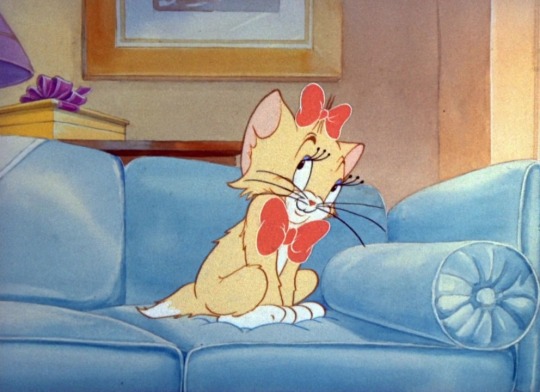

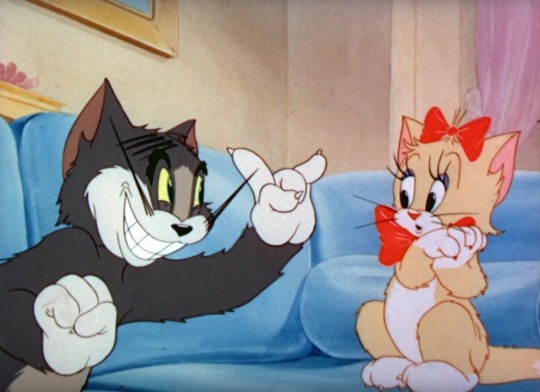
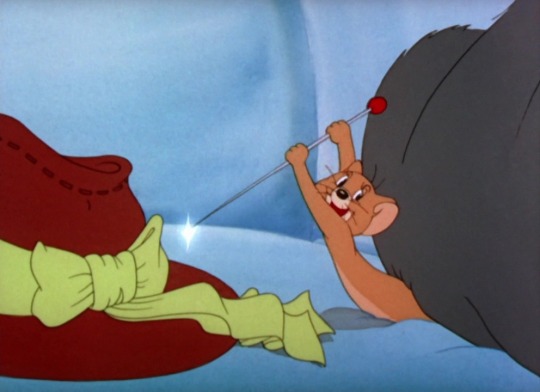




Puss n’ Toots (1942, Joseph Barbera, William Hanna, Rudolf Ising)
Tom and Jerry #6
11/30/22
19 notes
·
View notes
Quote
Hugh told me that Leon himself came up with the name "Looney Tunes," and later "Merrie Melodies." Could be, but at that time, the whole gimmick was music in cartoons. The main reason that Warners okayed the Looney Tunes deal was that they thought it would promote the songs they owned, from their movie musicals. When I started there, the rule was that we had to have a singing chorus in every Merrie Melodie. We'd have a great story going along, but then we'd have to stop and have the singing chorus.[...]
The first few Looney Tunes shown in 1930 made such a hit that Hugh and Rudy started Merrie Melodies early in 1931, which was just as I joined them. And they gave me a number of secondary characters to animate in the very first Merrie Melodie, Lady Play Your Mandolin. We made the Looney Tunes and Merrie Melodies at Harman-Ising until near mid-1933, when they split with Leon.
Clampett on the true origin of Looney Tunes and Merrie Melodies
#bob clampett#looney tunes#merrie melodies#quotes#warner bros#wb#hugh harman#Rudolf Ising#harman and ising#Leon Schlesinger#lady play your mandolin#foxy#bosko
16 notes
·
View notes
Photo
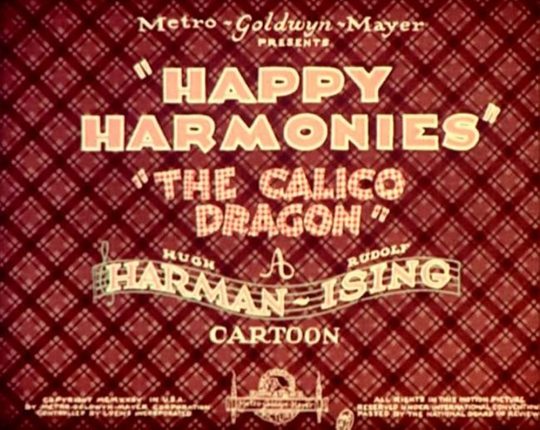

The Calico Dragon (1935) Rudolf Ising
January 16th 2023
#the calico dragon#1935#rudolf ising#the californians#johnny murray#happy harmonies (1934-1935 season) 9: the calico dragon#short#animation
2 notes
·
View notes
Text
youtube
Happy Harmonies: To Spring (1936)
To Spring is a 1936 animated musical short produced by Harman and Ising for the MGM cartoon studio's Happy Harmonies series.
Although the production credit goes to Harman and Ising this short was actually the first cartoon to be directed by the future cartoon giant William Hanna, along with animator Paul Fennell.
0 notes
Text
“Interrupted (again)” Todolf mafia au. I’m not sure if I posted the (kind of) prequel to this one, but it isn’t really needed to understand the story. Smut.
Rudolf had come down from his high long ago and was half dozing, basking in the fading afterglow, nuzzled against Tod’s chest, warm and strong, Tod’s softened cock still deep within him.
Tod plucks Rudolf’s phone from the end table on the first ring, glancing for a moment at the caller ID before handing the phone to Rudolf. Roger the Boss Man.
“Fuck.” He breathes, swiping to answer the phone a moment later and placing it on speaker.
“Rudolf?”
“Hello, Roger.” Tod adjusts their positions just a little and Rudolf places the phone on Tod’s chest, laying his head back down on the other side, letting his eyes flutter shut once more.
“Rudolf, I heard about what happened today - are you alright?”
“I’m fine, Roger. I’m fine.” Tod’s thumb starts making slow, soothing circles at Rudolf’s hip.
“Rudolf-” Rudolf can hear Roger let out a breath ever over the phone. “I think it would be best if I took you off the Tod case.” Tod’s thumb abruptly stops its little circles.
“No-” Rudolf’s voice raises as he sits up, glaring at the offending phone still perched on Tod’s chest. “You can’t, I’ve come so far.” His thoughts race as he glances up at Tod. The other man’s thumb starts again in steady little circles and Rudolf takes a deep breath before continuing. “Roger, I know this case inside and out. It would take too long to bring someone else up to speed.”
“Rudolf, you aren’t exactly getting results.” Tod’s lips quirk up in a half smirk at those words. “There is no shame in needing a pair of fresh eyes.”
“We already have a mole problem. This will make it worse.”
There was a long pause before Roger spoke again. “Rudolf, he dumped a body outside your office. This isn’t up for debate. I’m taking you off the case.”
“You are doing exactly what he wants you to do.” Rudolf speaks clearly and quickly, his eyes never leaving Tod’s. “Did they tell you what the note said?”
Rudolf doesn’t wait for Roger to respond. “It wished me a happy birthday. My birthday was four months ago, and Tod would know. If the body is even his doing then it is to make it look personal - so you’ll take me off the case. Don’t play into his hands.”
“Rudolf.” Roger’s tone betrayed a tiredness that Rudolf wasn’t expecting. “If anything more happens - when you are on duty or at the opera or whatever, I want to know. And I want to hear it from you, not Graham.”
“Alright.” Rudolf’s gaze finally dropped from Tod’s as he laid back down against his friend’s chest.
“Get some rest. And Rudolf - be careful. Please.”
“I will.” Rudolf ends the call at that, letting out a breath he hadn’t known he was holding.
Tod draws him closer, pressing a long kiss on Rudolf’s lips. “I’ve missed watching your lovely silver tongue do its work.”
Rudolf flushed, moving to hide himself in the crock of Tod’s neck, but Tod snapped his hips and Rudolf gave a little groan as he could feel Tod hardening inside him.
He half expects it to be Roger calling him back when the phone goes off again, but Tod is plucking his own phone from the table now. Tod raises his eyebrows, turning the phone so Rudolf can see who is calling. Roger Emmory (Uni).
Tod flips them so Rudolf is sprawled beneath him on the bed, thrusting as he did so, drawing another moan.��
“Yes?” Rudolf realizes he must have taken the call as he did so, placing it on speaker and laying it on the bed, not far from Rudolf’s head.
“Tod.”
“That’s me.” Tod’s singsong lilt was in complete contrast to the whimpering sound that Rudolf half swallowed.
Tod shook his head. Sing, he mouthed. Rudolf didn’t hold back the next noise. “Admittedly I do have company. How ever can I help you?”
“Stay away from ADA Habsburg.” Tod smirked down at Rudolf and thrust again, harder this time.
“Rudolf?” His name rolled off of Tod’s tongue. “Why? He’s such a delightful,” another thrust, and another moan from Rudolf. “Change of pace after those graybeards you kept on sending after me. And my poor ex-lawyer has court on Wednesday. I was thinking I would go to support the poor man.”
“I highly doubt any of your former lawyers are poor.”
“Touché. Mmmm. Do you remember what color your precious ADA’s eyes are? I always think of them as this warm brown. Pretty doe eyes. So welcoming.” His hand traced Rudolf’s jaw before Tod leaned down to kiss him.
“How much did you have to pay for one that would kiss you?”
“For shame, Roger. You think I need an escort to find a lover?” He kissed Rudolf again. “Though- you wouldn’t mind, would you, pet? If I called you Rudolf for the night?”
He continued. “I wonder what sort of lover the sweet ADA would make? He’s so very prickly in court, all silver-tongued and vicious. But no - I bet he’s submissive, pliant, soft as a lamb in bed. Shall we make a little bet, Roger?”
Rudolf could hear Roger sputtering on the other end of the phone.
“Perhaps not a bet, then. But Roger - I really must seduce your precious protégé sometime soon. Would probably do the boy some good to learn a thing or two about the pleasures,” Tod’s thrust punctuated the statement perfectly “of the world.”
“Now unless there is anything else, Roger, I am busy.” Tod hung up before Roger could answer.
“Are you trying to get me off the case?” Rudolf asked between moans as Tod brought both of them closer to their peaks.
“Mmmm. I promise to kill anyone who replaces you until they give me you back.”
“Stop making my life so difficult.”
Tod nosed Rudolf, leaning down to purr in his ear as their pleasure crescendoed “Oh but Rudolf, is your life not so much more interesting with me in it?”
Rudolf nuzzled into Tod fondly as he came down from his pleasure. “Yes.” He murmured, feeling Tod pull him closer, intertwining them as sleep finally came.
#todolf#my fic#todolf modern mafia au#modern mafia au#smut and pro#ises of violence#Tod is a bad man#Rudolf isn't much better
1 note
·
View note
Text

They’re friends. I’m actually Walt Disney AND Rudolf Ising
#art#cartoon#fanart#merrie melodies#30s cartoons#mickey mouse#merrie melodies foxy#Disney#rubberhose
25 notes
·
View notes
Text

Happening Hoofers “Fields Of Honey” (1990)
#90s#amblin#warner bros#tiny toon adventures#honey and bosko#original looney tunes#cameos#hugh harman#Rudolf ising#tiny toons#gif#dancing#pots and pans#honey#bosko
87 notes
·
View notes
Text

Warner Bros. Pictures Animation Logo With Bugs Bunny (Cinemascope)
Looney Tunes Belongs To Leon Schlesinger, Hugh Harman, Rudolf Ising, Harman-Ising Productions, Leon Schlesinger Productions, Warner Bros. Cartoons, Inc. DePatie–Freleng Enterprises, Format Productions, Warner Bros.-Seven Arts Animation, The Vitaphone Corporation, Vitagraph Company of America, Turner Entertainment Company, Warner Bros. Animation Inc. Kids' WB! The WB, The WB Television Network, Inc. Tribune Broadcasting Company, LLC. Tribune Media Company, Nexstar Media Group, Inc. Cartoon Network, Boomerang, The Cartoon Network, Inc. Warner Bros. Discovery Networks, Warner Bros. Domestic Television Distribution, Warner Bros. Television Studios, Warner Bros. Television Group, Warner Bros. Entertainment Inc. WarnerMedia, And Warner Bros. Discovery, Inc.
Bugs Bunny Belongs To Ben Hardaway, Cal Dalton, Charles Thorson, Tex Avery, Chuck Jones, Bob Givens, Robert McKimson, Warner Bros. Cartoons, Inc. DePatie–Freleng Enterprises, Format Productions, Warner Bros.-Seven Arts Animation, The Vitaphone Corporation, Vitagraph Company of America, Turner Entertainment Company, Warner Bros. Animation Inc. Kids' WB! The WB, The WB Television Network, Inc. Tribune Broadcasting Company, LLC. Tribune Media Company, Nexstar Media Group, Inc. Cartoon Network, Boomerang, The Cartoon Network, Inc. Warner Bros. Discovery Networks, Warner Bros. Domestic Television Distribution, Warner Bros. Television Studios, Warner Bros. Television Group, Warner Bros. Entertainment Inc. WarnerMedia, And Warner Bros. Discovery, Inc.
#bugs bunny#BugsBunny#looneytunes#looney tunes#the looney tunes show#warnerbrosanimation#warner bros discovery#warnerbrothers#warnermedia#warnerbros#warner bros#warner bros pictures#WarnerBrosPictures#WarnerBrosPicturesAnimation#WarnerAnimationGroup
5 notes
·
View notes
Text
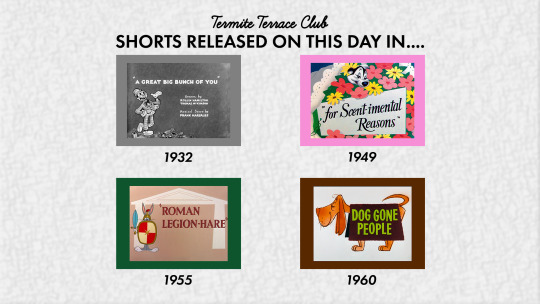

Termite Terrace Club - November 12th
1932 - A Great Big Bunch Of You - Dir. Rudolf Ising
1949 - For Scent-imental Reasons - Dir. Chuck Jones
1955 - Roman Legion-Hare - Dir. Friz Freleng
1960 - Dog Gone People - Dir. Robert McKimson
#LooneyTunes #LooneyTwt #pepelepew #penelopepussycat #bugsbunny #yosemitesam #elmerfudd
TV
1990 - Tiny Toon Adventures Season 1: “Animaniacs!”
1992 - Tiny Toon Adventures Season 3: “The Horror of Slumber Party Mountain”
1993 - Animaniacs Season 1: “Casablanca Opening” / “Fair Game” / “The Slapper” / “Puppet Rulers”
1994 - Animanaics Season 2 Finale: “I'm Mad” / “Bad Mood Bobby” / “Katie Ka-Boom: The Blemish” / “Fake”
1995 - Pinky and the Brain Season 1: “Brainania”
2005 - Loonatics Unleashed Season 1: “The World is My Circus”
#looney tunes#looneytwt#wb100#wb#warner bros#bugs bunny#pepé le pew#penelope pussycat#elmer fudd#yosemite sam
8 notes
·
View notes
Text
Iwerks was also the sole animator for this short and spent just two weeks working on it in a back room, at a rate of over 700 drawings a day.[6] It is also speculated Hugh Harman and Rudolf Ising might have done work for the short as well.[7][8]
How did Iwerks not kill himself working on this thing? The animation is so smooth and clever, with interesting little bits of action and movement across the layers of the stage layout. The short answer is probably his young age and accumulated work experience, but still! This short is going into the public domain next year, so I was inspired to check it out again on YouTube. I keep seeing comments nowadays like, now’s the time to make fun of the mouse! 🔥 (Due to some of the early work entering public domain, and ire towards the modern corporation). But besides the fact that this version of Mickey is different from modern iterations— I have suddenly the mental image of a crowd coming in with pitchforks and tar, only to be stopped short by the fact that the intended target is the most beautiful, charming little creature they have ever seen. It blows modern mass produced cartoon media (I’m thinking of the stuff targeted towards kids) on YouTube out of the water! The sheer facility with hand drawing that is displayed! The cleverness of the sound effects and the timing! 😭❤️ Honestly, if I had the time, inclination, and finding, I’d see this public domain work as a huge opportunity to stick it to the modern corporation by using this to create… And I just had an idea 💡 while sitting here in the airport of how to utilize the early version of Mickey in a modern, all ages show that is all about showcasing art/crafts/dance that kids could do at home with simple supplies and talking about the history of the crafts, while using animation as a theme to talk about the art of observation. Maybe one day, one day! In my imaginationland—
2 notes
·
View notes
Text
Looney Tunes/Merrie Melodies 1931 Episode 9: Smile, Darn Ya, Smile!
Written by Bob Clampett
Directed by Rudolf Ising
Animated by Friz Freleng & Carman Maxwell
Voice characterizations by Johnny Murray, Rudolf Ising, The King’s Men & Ken Darby

3 notes
·
View notes